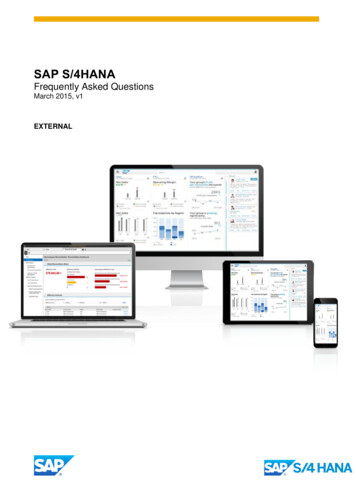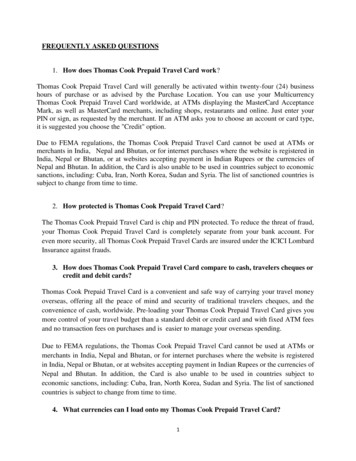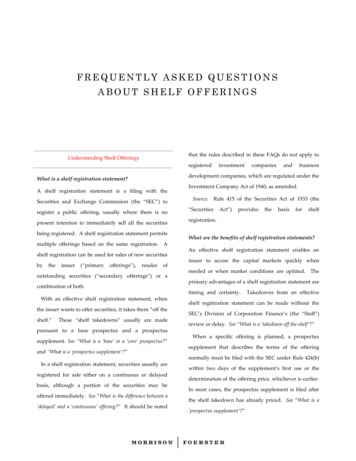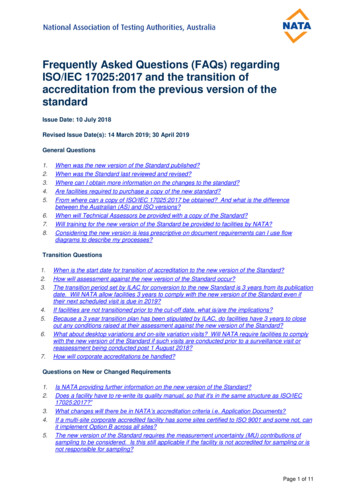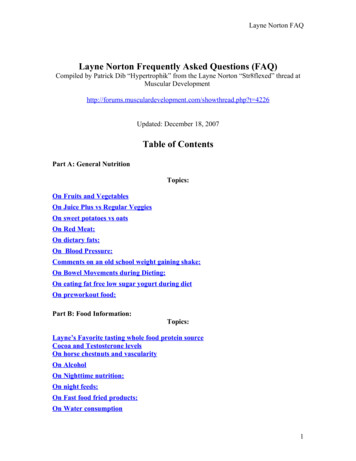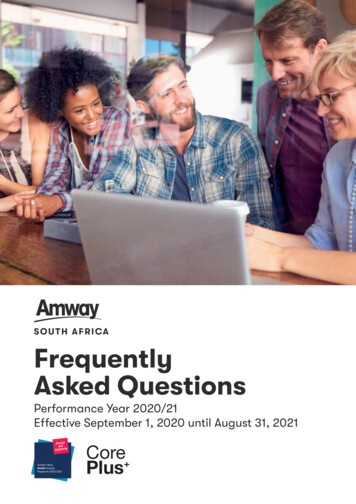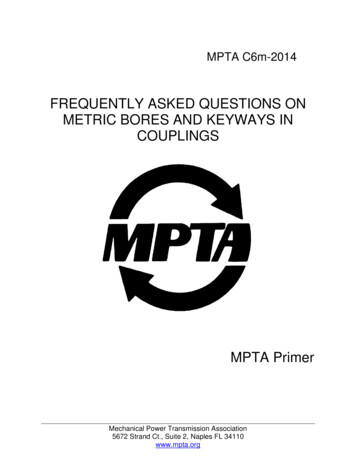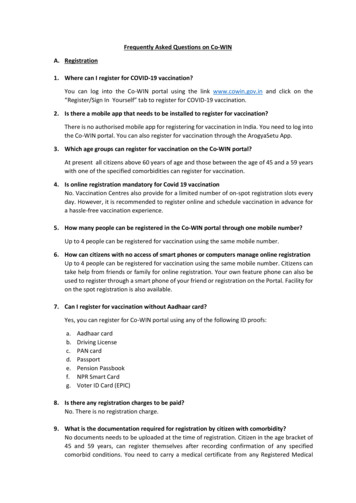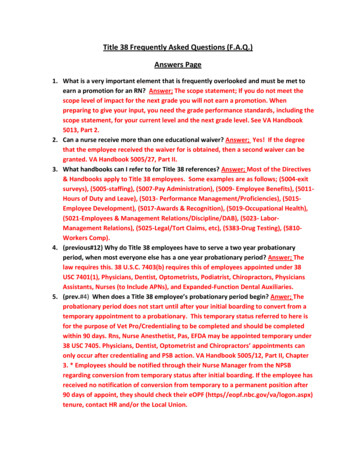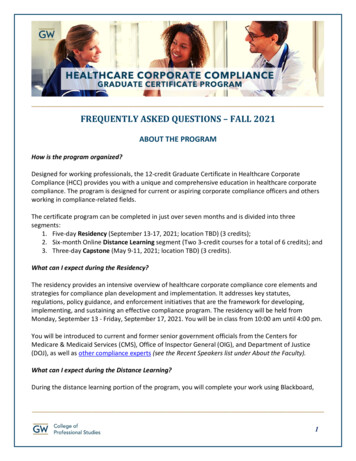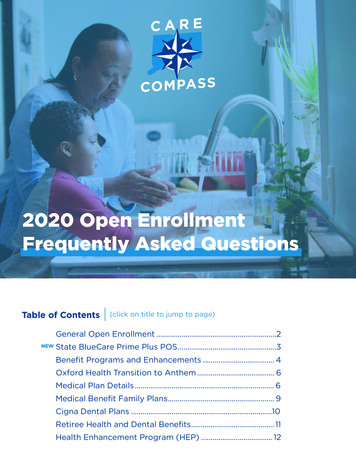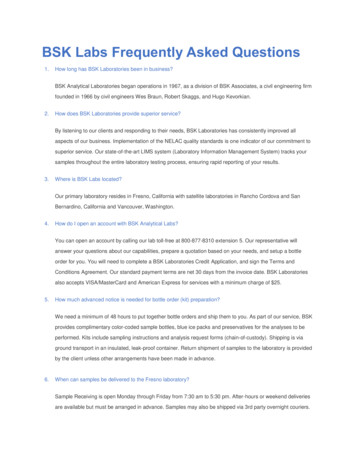
Transcription
BSK Labs Frequently Asked Questions1.How long has BSK Laboratories been in business?BSK Analytical Laboratories began operations in 1967, as a division of BSK Associates, a civil engineering firmfounded in 1966 by civil engineers Wes Braun, Robert Skaggs, and Hugo Kevorkian.2.How does BSK Laboratories provide superior service?By listening to our clients and responding to their needs, BSK Laboratories has consistently improved allaspects of our business. Implementation of the NELAC quality standards is one indicator of our commitment tosuperior service. Our state-of-the-art LIMS system (Laboratory Information Management System) tracks yoursamples throughout the entire laboratory testing process, ensuring rapid reporting of your results.3.Where is BSK Labs located?Our primary laboratory resides in Fresno, California with satellite laboratories in Rancho Cordova and SanBernardino, California and Vancouver, Washington.4.How do I open an account with BSK Analytical Labs?You can open an account by calling our lab toll-free at 800-877-8310 extension 5. Our representative willanswer your questions about our capabilities, prepare a quotation based on your needs, and setup a bottleorder for you. You will need to complete a BSK Laboratories Credit Application, and sign the Terms andConditions Agreement. Our standard payment terms are net 30 days from the invoice date. BSK Laboratoriesalso accepts VISA/MasterCard and American Express for services with a minimum charge of 25.5.How much advanced notice is needed for bottle order (kit) preparation?We need a minimum of 48 hours to put together bottle orders and ship them to you. As part of our service, BSKprovides complimentary color-coded sample bottles, blue ice packs and preservatives for the analyses to beperformed. Kits include sampling instructions and analysis request forms (chain-of-custody). Shipping is viaground transport in an insulated, leak-proof container. Return shipment of samples to the laboratory is providedby the client unless other arrangements have been made in advance.6.When can samples be delivered to the Fresno laboratory?Sample Receiving is open Monday through Friday from 7:30 am to 5:30 pm. After-hours or weekend deliveriesare available but must be arranged in advance. Samples may also be shipped via 3rd party overnight couriers.
For a nominal fee, BSK also has local couriers available within a defined geographical area. Please speak to aClient Service Representative for more information.7.Is there a minimum charge for testing?There is a minimum 75.00 charge per work order for services performed by BSK Labs.8.What is your standard turnaround time (TAT)?BSK Labs standard turnaround time is ten (10) working days or two weeks (exclusive of weekends or holidays).Standard TAT is calculated from sample receipt at the laboratory. Results are usually available at that time bytelephone and are followed by written results. Other factors such as sample matrix, lab capacity, subcontracting, and method requirements can extend the TAT.9.What rush turnaround times are available?A rush analysis, with verbal or FAX results, is available for an additional charge and must be arranged inadvance. In general, BSK Labs offers rush turnaround in 24 hours (1 day), 48 hours (2 day), or 5 days. Theserush commitments are based on samples being received before 12:00 pm on a regular business day. Samplesreceived after 12:00 pm will be scheduled for results starting from 8:00 am the following business day. If, for anyunforeseen reasons, the rush TAT commitments cannot be met, the next lower rush price will be applied.10. How much is a rush surcharge?24 hour (1 day) TAT is 3 times the normal fee; 48 hour (2 day) TAT is 2 times the normal fee; and 5 day TAT is1.5 times the normal fee.11. What is the definition of a sample holding time?The storage time allowed between sample collection and sample preparation or analysis, in conjunction withdesignated preservation and storage techniques. Holding times of 72 hours or less are calculated by hours;holding times greater than 72 hours are calculated by days.12. Which commonly performed parameters have short holding times?ASAP: pH; Total Residual Chlorine; Dissolved Oxygen (probe method); Filtration8 hours: MTF Coliform (Wastewater & Surface Watger); HPC8 hours: Dissolved Oxygen (field preserved Winkler method)48 hours: BOD; Nitrite; Nitrate (un-preserved); Turbidity; Color; MBAS; ortho-Phosphate; Settleable Matter (SM)
72 hours: Volatiles analysis of air bag samples30 hours: Drinking Water Coliform (P/A, 1X10 Coliform)30 hours: 1X10 Colilert, Quantitray13. How low can analytes be detected? What is an MDL? LOQ? RL? PQL? DLR?There are many terms used in the environmental laboratory business to describe the lowest detectablequantities of analytes in a sample matrix. While many are similar, BSK Labs uses these definitions for finalcalculating and reporting of results:MDL (Method Detection Limit): Minimum concentration of a substance that can be reported with 99%confidence that the analyte concentration is greater than zero. Empirically determined by each laboratory foreach analyte, method, instrument, and matrix.LOQ (Limit of Quantitation) or RL (Reporting Limit): Generally chosen to be three (3) to five (5) times theMDL, but can be as close as two (2) times the MDL. Regulatory requirements and method backgroundinterference also influence the setting of the LOQ. For the ease of reporting, generally the LOQ is chosen to thenearest ratio of 1, 2, or 5 times the MDL.PQL (Practical Quantitation Limit): The term used by BSK Analytical Laboratories for the LOQ or RL on theCertificate of Analysis.DLR (Detection Limit for Reporting purposes): The minimum DLR is set by the California Department ofHealth Services (DHS) for analysis of constituents in drinking water.MCL (Maximum Contamination Limit): Not a reporting limit value, but can be confused with reporting limitabbreviations. The MCL is a value assigned by California DHS as the maximum allowable value of a compoundin drinking water.14. Why are the detection limits sometimes elevated in a result?The detection limits that can be achieved on actual environmental samples can be influenced by a number offactors such as sample size, final extraction volume, injection volume, dilutions, instrument sensitivity, andmatrix interference.15. What is matrix interference?Matrix interference refers to sample characteristics that interfere with the test method execution such thatreliable data cannot be generated. Examples of matrix interference include samples with extreme pH, highalkalinity or acidity, and chemical constituents that react with target analytes. Common matrix interference is thepresence of a non-target compound in high concentrations. Even though this compound may not be of interestto the client, the sample often requires dilution in order to prevent contamination of instrumentation.
16. What is a surrogate? Why is it reported with my sample results?Surrogates are known analytes added in known amounts to samples and method blanks to evaluate theefficiencies of sample preparation steps for some methods. They are similar chemically to the target analytes ofthe method, but are not found naturally in samples. For that reason, many are isotope-labeled target analytes(i.e. toluene-d8). Because surrogates are added to each sample, the surrogate recovery result (expressed aspercent of recovery) is reported with each sample report.17. What is the purpose of the Case Narrative included with the final report?The case narrative documents laboratory comments with regard to sample container and receiving issues,special handling results, QC comments about the test methods, and any other factors that might have affectedthe sample or testing procedure outcome.18. How do I know if my water is safe to drink?BSK Labs does not make evaluations or recommendations regarding results. Pleasevisit www.epa.gov/safewater for more information about drinking water standards.19. Does it matter if soil data is expressed in dry or wet weight?Yes. In wet weight, (or "as received") reporting, the concentration of analytes is reported based on the wetweight of the soil sample. In dry weight reporting, the concentration is adjusted to remove the moisture contentof the soil from the reporting units. Results can be converted to either unit of measure as long as the moisturedetermination is performed.20. How do I take a water sample properly? How do I sample for Total Coliforms in drinking water?BSK Labs provides sampling classes for proper sampling techniques. Please call to schedule a place in thesampling class. Sampling Instructions are also available at www.bskassociates.com.21. What is a California EDT or WriteOn report? Are my results reported to the State of California automatically?The State of California Department of Public Health – Division of Drinking Water, maintains a database of allwater quality test results for regulated drinking water utility systems. The data is electronically submitted to thedatabase via Electronic Data Transfer (EDT), prepared by laboratories according to the state provided WriteOnprogram and protocol, which can also print a document version of the results in a "WriteOn" format. All samplesubmissions must indicate on the Chain-of-Custody if results are to be submitted to the state by EDT. For moreinformation, visit their website at: https://www.waterboards.ca.gov/drinking water/programs/ .
22. What are the types and purposes of the preservatives used in sample bottles?Acids and bases are used to adjust the pH of the sample: Sulfuric acid (H2SO4); Nitric acid (HNO3); SodiumHydroxide (NaOH); Monochloroacetic acid - MCAA (C2H3ClO2); Ammonium Chloride (NH4Cl). Dechlorinatingagents remove residual chlorine at time of sampling: Sodium Thiosulfate (Na2S2O3); Ascorbic Acid (C6H8O6).Specialized methods use other preservatives: Zinc Acetate-ZnAc (C2H2O2Zn); Ethylenediamine-EDA(C2H8N2).Disclaimer: As an educational tool, this page is intended to reflect usage of terms, principles, and practicesby government agencies, and the Quality Assurance documents of BSK Analytical Laboratories, but not toreplace any legal, regulatory, or mandated language. Please contact the BSK Analytical Laboratories QADepartment for clarification, or the appropriate state agencies for regulatory guidance and requirements.
BSK Analytical Laboratories began operations in 1967, as a division of BSK Associates, a civil engineering firm founded in 1966 by civil engineers Wes Braun, Robert Skaggs, and Hugo Kevorkian. 2. How does BSK Laboratories provide superior service? By listening to our clients and responding to their needs, BSK Laboratories has consistently improved all aspects of our business. Implementation of the
